| This article is a featured article, one of our top articles. |
| Kings | |||||
|
| |||||
| Hexacode | KI-01-01 | ||||
|---|---|---|---|---|---|
| Population | 64,292[1] | ||||
| Language(s) | (Urban) Lovian English Standard English | ||||
| Governor | Desmond Brown | ||||
| Deputy Governor | elections to be held | ||||
| Capital | |||||
| Islands | Kings Island | ||||
| Nicknames | The forest(ed) state Green dot in the blue Green spot Lonely island | ||||
|
| |||||
Kings is one of the states of Lovia and is located in the eastern part of the archipelago. It is named after the only island in the state. Because the political and geographical boundaries of Kings are one and the same, it is a rather isolated region that has evolved independently. This state has known its greatest expansion approximately between 1950 and 1960, when Lovian industry was booming. Nonetheless, the state is most known for its natural beauty as the economic centers are kept away from the inland. Kings neighbors the states of Sylvania and Seven, and the current governor is Desmond Brown. The capital of Kings is Newhaven, the second most populous city in Lovia.
The official hexacode abbrevation of Kings is KI and the total hexacode is: KI-01-01. The seal and flag of Kings both feature blue tones to refer to the water and a typical Kings pine. The seal also has the state's motto on it, 'surrounded by nature'.
History[]
Discovery and early years (1877-1900)[]
Kings was one of the first states of Lovia to be explored. In 1877, the first year of Lovia as a nation, already two expeditions were made from the Noble City settlement. The first expedition, lead by founding father Andrew Johnson mapped the shores of the isle and possible locations to start a settlement. A second expedition soon followed, this time under the lead of Lawrence Sagan who would become the first governor of Kings later on. Sagan and his crew of settlers started a small farming town along a river they named The Abby. They would use it as a base camp to discover the inland of the isle. The authorities however wanted to focus on expanding the capital instead of engaging resources for the scouting of King's highland regions. Despite this, inland settlements, founded mostly by new immigrants, slowly popped, mostly basing their economy on either farming, logging, or fishing, with a handful of mining-based settlements as well.
The original farming settlement steadily grow to a village of over 1000 people and was dubbed Newhaven. It was the preceder of the neighborhood of the same name and was the second largest settlement until 1880. By then, the Hurbanovan mining industry had gained the favor of the authorities in Noble City which meant that fewer investments were accessible for the other regions. The economic potential of Oceana and the dissatisfaction with the people of Newhaven lead to the construction of a confederal model with different states. Through this autonomy, the local leaders hoped to gain some economic momentum. In the 1880s, another major settlement popped up: Portland, a southern settlement based mostly on farming. Later, in the 1920s, the hamlet of Beaverwick, north of Newhaven, would grow into an important port for the state.
The economic state (1900-2000)[]
It was Sagan who got elected as the first governor of Kings in 1905 but it would take over a year before there actually was a policy. Kings was one of the poorest of the states on the archipelago, and the political autonomy didn't change much to this situation. Many governors passed without any success; most changes in favor of the common man were made in Noble City when social regulations and voting rights were added to the law in the '30s and '40s. The progressive and social(ist) parties that were elected in Congress kept focussing on the expansion of the capital but with the changes in the world economy after WWII, change was on its way.
The demand for mining products declined and the Oceana economy suffered due to this. In the mean time, environmental activists protested against the seemingly endless urbanization around Noble City. The authorities had trouble pushing through economic reforms in these areas because the people were afraid of losing their jobs. This created an opportunity for Kings, were the people had been workless for years. The socialist governors that headed Kings in the '50s and '60s invested in the expansion of modern industries and ordered the construction of an harbor. Old Port and Abby Springs were build and both economy and population rates finally took of.
In the decades that followed Kings, and especially Newhaven, had become the stronghold of the Lovian economy. Growth rates slightly fell during the economic crises of the '70s and '90s but never went below four percent. The politicians kept exploring new industries and near the end of the century technology and research companies were drawn to Lovia. A huge project was started to build a new neighborhood especially for business centers and administrative buildings. By the end of the 1990s, Malipa had been constructed, and Newhaven was known as the economic hotspot of Lovia, with importance in both shipping and newer, often high-tech, industries.
Modern day Kings (2000-2010)[]
Kings had regained its position as second most populous region of Lovia, with over forty thousand inhabitants in Newhaven alone. It also got over chronic economic slumps by beating Sylvania's economic growth rates. Newhaven kept expanding by constructing the neighborhood of East River in the 2000s, and partially developing the once completely natural area of Pines. Because of the economic activity and years of progressive governors, the old poverty has made room for the wealth of today. The rise of Kings culminated in the election of mayor and governor, Yuri Medvedev as Prime Minister of Lovia in 2008 and a second time early in 2010.
Kings has quite well been able to withstand the financial crisis of 2007-2010 because Medvedev betted on an underestimated trump of the isle: its natural beauty. The governor realized what potential Kings had to become a tourist destination. Because Lovia was relatively unknown with European and even American travelers, a holiday would be cheap compared with popular destinations. Since 2005, Kings's politicians have invested in expanding tourist facilities in the central and southern regions of the isle, away from the economic centre at the northern shores.
Lovian Civil War of 2011[]
In October 2011 a civil war broke out in Lovia. Initially the rebels were limited to the states of Clymene and Seven, with only a minor campaign south of Newhaven. The United Nations peacekeeping mission UNLOR had control over Kings for the majority of the conflict. During a small surprise-offensive of Southern Kings nationalists, most of the region of Southern Kings was temporarily in rebel hands, with the final pockets of Southern resistance falling a week after the uprising. These southerner rebels of the HAMR Movement were however easily dealt with once UNLOR reorganized and responded.
The conflict reached a new height upon the joining in of Oceana nationalist movement Oslobodenia and the subsequent change of heart of Oos Wes Ilava. With two states largely in rebel hands and the fate of Sylvania and Clymene uncertain, Yuri Medvedev called for the creation of a neutral zone in Kings. Medvedev placed Kings outside the conflict, and effectively outside government control, by having UNLOR detaching defensive troops to the island. A no-fly zone was installed later on in Operation Badlands. Kings was under martial law during the uprising in Southern Kings and lasting until localization of rebels to the City Archipelago. Kings was largely unaffected by later political turmoil within Lovia, such as the Burenian invasion.
Geography and nature[]
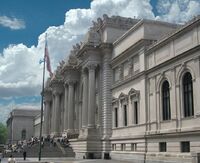
The Lovian Museum for Modern Art

The Newhaven city hall
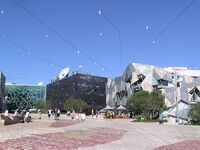
Federation Square, Malipa
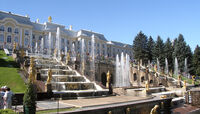
Fountains at the botanical institute
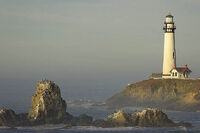
The Queen Lucy lighthouse
Kings is formed by only one island, Kings Island. It is a green and hilly state that is famous for its huge pine forests. The biggest part of the state is rather sparsely inhabited, except for the valley of the Abby, where Newhaven lies. The river forms the main transportation for industries, together with the railways. After Newhaven, Portland in the south, Beaverwick in the northwest, and to a lesser extent Westmark in the southwest and Nordhorn in the northeast are the most populous areas. There are also several hamlets in the central regions and the highlands.
The economic areas are centered in the north and along the coast whereas the inland contains unique natural beauty. About 80% of the flora in Kings occurs only in Lovia, and than again mainly on Kings. About 60 percent of Kings is still covered by its natural vegetation and more than half of that is forest. Roads and towns are always carefully planned in order not to harm the isle. The state of Kings also has extensive marine resources, with the fourteenth-largest Exclusive Economic Zone[2] in the world, covering over 220 square kilometres, more than 3 times its land area.
Cities and towns[]
- Newhaven is a city in Kings and functions as the state capital. It lies at the mouth of the river Abby, along the northwestern shore of the Isle. Both the surrounding basin and bay are named after the city. Newhaven is the economic, cultural and political hotspot of Kings with most inhabitants of the isle living in the city. Newhavin itself is divided into six neighborhoods, Newhaven, Abby Springs, East River, Malipa, Pines, and the Old Port. The huge Newhaven port is located in the new city of Newhaven. The new city was developed in 1960 together with Abby Springs due to an expansion of the economic activity.
- Places of interest:
 Newhaven - The oldest neighborhood in the city which forms the major part of Newhaven.
Newhaven - The oldest neighborhood in the city which forms the major part of Newhaven.
- The famous Lovian Museum for Modern Art which has the biggest art collection in Lovia
- The modern Newhaven Shopping Center where you can drink at Medvedev's or Malipa Burger
- King's parish of the Unified Lutheran Church to reflect quietly or just for its architecture
- The recently built Newhaven Stadium, where you can watch the Newhaven Rockets practice
- Abby Park, a municipal park which was quarried for its rock to build Newhaven's new roadways
 Abby Springs - A quiet and beautiful residential neighborhood where most of the Newhaven families have their home.
Abby Springs - A quiet and beautiful residential neighborhood where most of the Newhaven families have their home.
- The Newhaven site of the Blackburn University, Lovia's most prestigious educational institute
- The building of the political think tank TCSS, nicknamed The Pineapple due to its shape
- Greenpark, a series of four parks covering 955 hectares spread around the neighborhood
- Template:ERSeal East River - One of the newest neighborhoods, consisting of mostly residential area.
- The Grand Mosque of Newhaven, one of only three mosques in Lovia
- 1 Greenpark Avenue, the residence of the Governor of Kings
- Newhaven General Hospital, the second largest hospital in the nation
 Malipa - By far the most luxurious neighborhood in Lovia, Malipa is the new political, social and cultural center of Kings.
Malipa - By far the most luxurious neighborhood in Lovia, Malipa is the new political, social and cultural center of Kings.
- Governmental buildings like the Newhaven City Hall, the Kings State Capitol or the Central Library
- Federation Square, the cultural heart of Lovia and home to the annual Malipa Cinema Festival
- The Malipa Civic Auditorium which is home to various conferences, lectures, theater and film
- Federation Park, where you can enjoy long walks, bicycle trips or even recreational horseback riding
 Old Port - Grown from a small farming and fishing community, this is the logistic and industrial center of Kings.
Old Port - Grown from a small farming and fishing community, this is the logistic and industrial center of Kings.
- The Harbor of Old Port alongside the Abby, the two pieces of water that made King's economy boom
- Camping sites like the popular Blue Abby Camping, hosted by Newhaven Campings
 Pines - A mostly natural neighborhood, consisting of a very large park along with some residential areas.
Pines - A mostly natural neighborhood, consisting of a very large park along with some residential areas.
- The biggest park in all Lovia, the King Lucas Park with its beautiful arrangement of fountains
- The adjacent King Lucas Botanical Institute with a vegetation museum and a medicinal library
- Portland is the largest town on the east coast of Kings and grew out of several small settlements in the southern region of the isle. Recently it received the status of tourist capital of the isle for the town is the gateway to multiple tourist hotspots in Lovia such as the Abby Highlands, Eastern Plains and The Grand Bay. Portland is the fastest growing settlement in the country since major investments have been made by notable officials; an example of this booming town is the Kings Administrative Tower. Portland has two neighborhoods, Hurket-on-Kings and Bayfield. The symbols of Portland are grapes and the colors red, white and navy.
- Beaverwick is a Lovian village in the State of Kings, northeast of the state capital Newhaven. It is located along the shores of the northern tip of Kings Island. Beaverwick grew out of a settlement of fisherman and today still serves as a dock and home to fishermen and their families. The dock of Beaverwick is also used as the operating base of several ferries to various locations in Lovia, most notably the states of Sylvania and Seven. It also functions as a secondary port to Newhaven.
- Places of interest:
- The Queen Lucy Lighthouse, build in 1950
- The ferry home base King's Docks
- The green oasis Normandy Forest
- Pines Forest, the natural forest with the typical trees surrounding most of Newhaven
Geographic zones[]

A topographic map of Kings
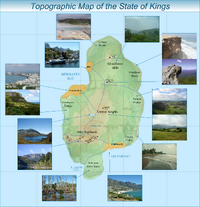
Map showing the isle's beauty
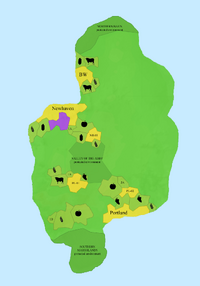
Map showing the land use in Kings
Northern region[]
Generally, 'northern region' is used to refer to the part of Kings that lies north of Deluded Rock. It is also called Kings' northern tip in a less formal manner of speech. The northern region is a forested and hilly region with very fertile soil and is for the largest part covered by the Grandforest Hills. The woods of Grandforest Hills are very dense and wet, the only accessible route being the hiking pad passing over Grandforest Top, with its 595 meters the highest point in these deciduous forests. Another landmark in this region is the above mentioned Deluded Rock which became notorious after the eccentric Sir Garth Pancake tried to mine the mountain for gold of which he wrongly supposed it was there. Underneath the Grandforest Hills lies another hiking trail which is used as the southern boundary of the northern region.
In the extreme north of the isle lies the Northern Basin, this is geographically the youngest part of Kings. Small geysers and volcanic puddles are scattered across the region. This activity is part of the volcanic hotspot that is also responsible for the formation of the isles of Seven. On the eastern shores of the northern tip the volcanic sediments are worn out by the heavy winds and sea storms that are typical for the region. These Windthorn Shores as they are called thus consist of barren cliffs and naked rock shores. These form a friendly environment for small crustaceans and wadding birds of which several species have their nesting area along the coastline.
Central region[]
The central region consists of the valley of the Abby and the Eastern Plains. The latter one is the geographical least interesting part of Kings. It is where the cliffs have almost completely disappeared and have made room for a slightly sloping landscape of fields and low hills. The natural vegetation of Eastern Plains is a combination of open fields, small parts of forests and lots of coastal grasses. These lands are home to the animals more commonly associated with easy accessible shores like terns and gulls. Towards the inland of the central region levels rise quickly and the Central Heights thus have a totally different natural composition. The climate surrounding the highest point of the heights, the 520 meter high Central Hill, is suited for the typical pine forests to thrive. The Central Heights are also the home to Kings' most unique animal, the Lovian Dassie.
Near the mouth of the Abby lies the Newhaven Basin and the Newhaven Bay. This is the most urbanized part of the isle's landscape but most of the nature has remained intact. Besides the agglomeration of Newhaven and same farming grounds southwest of the city, the basin is covered with pine forest. The richness of this region comes forth from the minerals carried from the southern mountains by the Abby. The valley of the Abby, situated between the Central Heights and the elevated southern region, is home to the larger animals of Kings and very popular with tourists. Especially the isolated Abby Lake is of great importance to the balance between man and nature.
Southern region[]
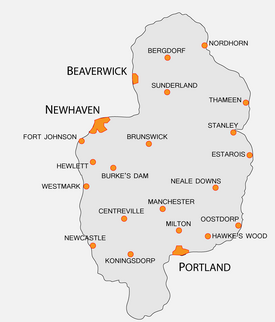
A map showing all the settlements in Kings
Most significant to the southern region are the Abby Highlands, named after the river which wells in the mountain area. The Highlands are the result of the younger island - land formed by the hotspot in the north - pushing the older parts of the isle together. Lovia's highest point, the 946 meter high Kings' Peak, is situated in this area. Together with the other peaks, which are all interconnected by a single hiking trail, it is the main tourist attraction of Kings. One other rareness worth mentioning is the Coastal Giant, a mountain that lies fairly isolated at no more than two kilometer (1.2 miles) of the coast. The landscape of the Highlands is again more barren, with lower vegetation and more open spaces. The most common animals in the mountains are small reptiles and amphibians which are best adapted to the rocky surrounding.
Just east of the Highlands lies the Coastal Valley which is popular with beach tourists because of its less tricky climate than the higher regions. The Coastal Valley has regular sand beaches with small forested areas behind the dunes. The valley is situated at the rather quiet Grand Bay were water sporting and ferry sightseeing are regular activities. Southwest of the valley and in the southernmost tip of Kings the unique Southern Marshlands have developed. This was possible because it was shielded from winds and stormy weather by the higher and central regions of Kings. The wet marshes are home to small crocodiles and unique bird flocks and only partially open to the public. Most areas in the marshes are off limits to protect the delicate environment. The Southern Marshes and the region of Portland are considered a microclimate.
Soil composition and land use[]
Over half of King's surface is still covered by its original vegetation and has not been given a special designation. Much of the island is still covered with natural forests. Only about thirty percent of the land is taken in use, but this also comprises protected areas. Kings has three of these so called 'protected environments': the Northern Basin at the northern tip of Kings, the Valley of the Abby in the center of the isle and the Southern Marshlands. If those natural parks are considered as non-designated too, about forty percent of Kings' surface is in use. Of the designated grounds, one quarter is agglomerated with Newhaven and Portland as centers. In the highlands between these two localities several minor settlements and farms can be found. Just outside Newhaven there also is a village, Beaverwick. The only industrial grounds are to be found in the Newhaven neighborhood of Old Port and Beaverwick.
The black, loose soil of Kings is very suitable for raising crops but also allows the growth of various grasses, which are essential for the feeding of livestock. Kings' soil is fertile due to the minerals distributed by the volcanic activity in the north. In the southern regions of the isle, around Portland's micro-climate, grapes and fruits are being grown. The more northern you go, the more grains and livestock become predominant. Especially in the areas near Beaverwick, vast grazing lands can be found. Wheat can be grown all over the isle, while other grains like maize are generally limited to the northern half.
Economy[]
Chronologic overview[]
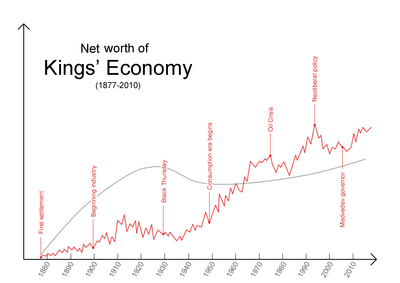
Graph of King's economic value (1877-2010); Lovian mean in grey
Kings has long been one of the poorest states of Lovia, its main economic activity being agriculture, and to a lesser extent fishing, logging, and mining. Money was always drawn away from Kings by the economic more interesting areas like Noble City or the Oceana mining areas. It wasn't until Kings became a state with its own governor that an actual economy was shaped. It remained hard to find any investors so the authorities expanded those fields of the economy that didn't require lots of money, like fishing. Unfortunately fishing didn't generate much income since there was a competition going on between Kings and the other 'poor states', Clymene and Seven.
Economic momentum was finally gained when the other states got bugged by rapid modernization of the economy and the rise of environmentalist and leftist movements. Those pressure groups were asked to help with the new plans for King's economy. The main goal was to give Kings a modern and developed economy to work away the income gap with other regions but without hurting the natural environment. The socialist governors that headed Kings in the '50s and '60s invested in the expansion of modern industries and ordered the construction of a harbor. The harbor and the river Abby were key elements in the development of Kings. The industrial centre was - and today still is - located on the northern shores and along the Abby.
In the decades that followed Kings, and especially Newhaven, had become the stronghold of the Lovian economy. Growth rates slightly fell during the economic crises of the '70s and the '90s but never went below four percent. The politicians kept exploring new industries and near the end of the century technology and research companies were drawn to Lovia. By 2002 Newhaven, and thus Kings, had become the economic hotspot of Lovia. Kings delivers by estimation 34 percent of the Lovian GDP and its inhabitants have a high standard of living as well. Kings largely escaped the early 2000s recession that impacted upon most other States due to its investments in ecotourism. As of 2006, Kings median household income was only 4% less than in the United States.
Composition[]
Kings has since it was first settled evolved from a mainly agricultural economy to a more balanced one. In the early years of the isle, even before it became a state, farming and fishing made up most of the economy, with the rest being logging and mining. Besides a small grocery shop and some people earning extra money by doing handy jobs there were no real economic activities. Most finished goods and even a large proportion of mined materials were imported from Peace Island. In later years, the importance of fishing grew until its share in Kings' economy had become half of that of regular agriculture. Also, by the time states were introduced, Kings had attracted some beginning companies that couldn't afford the expensive terrains on the main island. The industry had a share of about one tenth in the economy's composition, still nothing compared to the industrial complexes of Sylvania and Oceana. Due to the island's volcanic origin, apart from the Utkin-Kowalski Salt Mine, and a few small metal and coal mines, mining has played only a small part in the state's economy.
The big growth of Kings's economy of the '50s and '60s was mainly situated in the industrial area and by that time it had become the largest branch of the economy. Its share had gone up to over forty percent. Kings became more attractive to other companies to settle due to cheaper grounds compared to the other states. This industrial growth also caused several service companies to settle in the state. Nowadays, Kings has a balanced and relatively autarkic economy. The portion taken by pure industrial activities has stagnated while still about one third of the economy is made up by farming and fishing. The biggest growth in the latter years was for the service providing sectors, mainly catering and tourism.
The evolution of Kings' economic composition over the years. ██ = farming ██ = fishing ██ = industry ██ = services
Also striking is the growth rate of the public and cooperative sectors in the past two years. Under governor Medvedev, the large public investments have been made. Also, like on the federal level, the government involvement in economic activities have increased since 2008. As the Kings Public Service Company the state participates in the market or acts as a regulating factor. Next to monopolies on the infrastructure, the State of Kings also supports cooperatives such as technology company TINA or the Cooperative Farming Initiative. About 40% of Kings' economy is in some way connected to the state.
Demographics[]
Kings has a population of about 70,000, of which approximately 78% identify with European ethnic groups. Of the total Kings population, 32% are British (a large proportion of which are from Yorkshire), 18% are French or Walloonian, 16% are Dutch, Libertan or Flemish, and 15% are German. Kings is also a predominantly urban state, with 82.2 percent of the population living in the main urban areas and more than half living in the largest city of the island, Newhaven. Only about 8% of the people live outside Newhaven or Portland, with concentrations in Beaverwick and the other villages and hamlets.
Kings has relatively open immigration policies; its government is committed to increasing its population by about 2 percent annually for economic reasons. This causes that about twenty three percent of King's population was born overseas, one of the highest rates anywhere in the world. At present immigrants from Libertas and Adlibita constitute the largest single group, accounting for 29 percent of those born overseas. According to the 2006 census, most Kings inhabitants are atheist. A small but important part is Christian. The main Christian denominations are Anglicanism, Roman Catholicism and other forms of Protestantism. Religion does however not play a major role in Kings public life, having no religious points of interest or important churches.
Culture[]
Kings is generally split between the northern (centered around Newhaven) and southern (centered around Portland) cultures, as well as the differences between the largely German population in the north, French population in the east, and Dutch and British populations in the central, western, and southern areas. Though the differences in ethnicity have become less important over the years, the economic development of Newhaven compared with the continued agricultural focus on Portland has divided the state, with the north generally being more progressive and the south more conservative. However, the culture of Kings has been heavily influenced by Sylvania, resulting in a relatively undistinguished culture besides those brought with the German, French, British, and Dutch immigrants.
Political[]
Kings is known as the most progressive state of Lovia, with many socially engaged politicians being popular in the state. This is due to the harsh economic and social situation of the past for which the liberal and conservative politicians of the first decades in Lovian history are often blamed. In recent years, socialist and green parties have scored notably higher in Kings than in other states, the scores lying about ten percent higher than the national mean. There is little difference between the urbanized and rural regions, because the people of the later one go often to the city to go shopping and bring the children to school, et cetera. Despite the similarity, rural regions do tend to vote for more conservative candidates on average. Kings had usually been governed by left-aligned governors in the past, but it is only recently that a communist has occupied both the post of mayor of Newhaven and governor of Kings. Though, Yuri Medvedev's position was somewhat controversial, most inhabitants support him for the good work he did in the years he was in power. Nevertheless, he was narrowly voted out in favor a more moderate candidate, William Krosby, in 2011.
Nowadays, the politics of Kings has moved somewhat to the right, like the rest of Lovia. The exact reason for this is unclear, but it may be due to the aftermath of the Lovian Civil War. The left certainly suffered a huge blow when Medvedev retired from politics in December 2011, leading to the marginalization of his party, the communists. Labour was also hit hard when its main leader in Kings, Jhon Lewis, defected in favor of the CCPL. This left moderate William Krosby of the SLP as the only major progressive politician in the state, who was elected by a narrow margin twice in 2011 (over Medvedev) and 2012 (over Lewis). Many commentators were shocked by his upset victory over Medvedev in 2011, astounded in 2012 when he struggled to beat the CCPL challenger Lewis, requiring a recount, after the CCPL had never succeeded before in getting over 15% of the vote. One explanation for the events is that CCPL's shift farther to the left, economically speaking, made the party more appealing in Kings, as did the relatively progressive candidate. Furthermore, the large CCPL vote can be seen as a protest against Krosby, who many inhabitants of Kings saw as having achieved little in his first term. In the 2012 election, Labour candidate Annabelle Mayer did poorly, compared to previous results for leftist candidates. Conservative Nationalist Party candidate Neil Hardy was voted in in the 2014 elections, perhaps due to the splitting of the vote among leftist candidates. He later defected to the Conservative Christian Party of Lovia.
The political level is very dominant in Kings, intertwining with almost everything else. Not only is there a strict planning of urbanization and management of natural resources, but also most cultural activities are organized and subsided by the government. Even economic and industrial activities are guided by the authorities. A few examples are the state-operated dock and airfield of Old Port and the cooperation between farmers settled in Pines and the King Lucas Botanical Institute.
State elections[]
In the state elections of 2011, Medvedev, previously governor for several years, was demoted to the position of deputy governor following his narrow defeat to centrist politician Krosby. Krosby won with 36% of the vote, beating Medvedev by a single percentage point. It is suspected that the socialist vote was split by the entry of then-Labour politician Jhon Lewis. In the following elections of 2012, the vote was again close, but a conservative candidate, Lewis, was the one who nearly defeated Krosby. In the 2013 state elections, Marcel Cebara of UL became Governor, winning 45% of the popular vote. Jhon Lewis came in second place, and won a second term as Deputy Governor. In 2015, Neil Hardy, a member of the Conservative Christian Party of Lovia, was elected as Governor of Kings. For the list of all former governors of Kings, see this page. Independent politician and former Governor of Kings Desmond Brown was elected the new governor in 2015.
State institutions[]
Kings is considered a progressive and advanced state compared to other states. The Kings State Court and the Kings State Police existed as institutions on state level until the 2010 constitutional reform by which powers were centralized on the federal level. The decline of the state as a political player was however countered by governor Medvedev by creating new institution like the Kings Public Service Company which runs all enterprises of the state. Next to the economic activities the state also preserves endangered environments under the Kings State Park Service. It is unclear whether these new institutions will in the future conflict with federal regulation, but governor Medvedev made clear that the institutions are merely to 'guide biasses towards a better regulation when federal initiative is missing'.
References[]
- ↑ These figures are registered and measured on January 4, 2014 by the Kings Demographic Center.
- ↑ Under the law of the sea, an Exclusive Economic Zone (EEZ) is a seazone over which a state has special rights over the exploration and use of marine resources.




